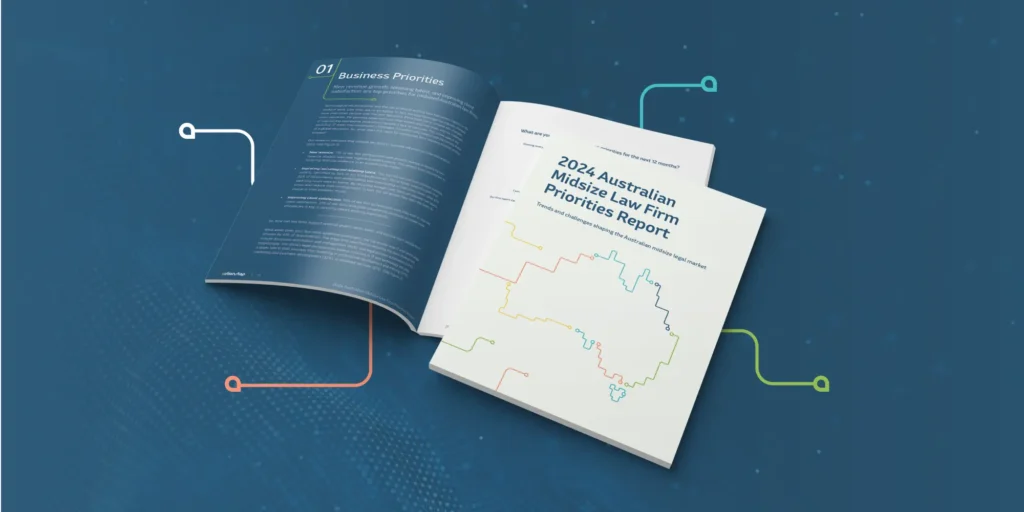Full report: https://www.actionstep.com/resource/2024-australian-midsize-law-firm-priorities-report/
Actionstep surveyed law firm professionals from midsize law firms across Australia to find out how their organisation is evolving and what they’re anticipating in the next year. The research addressed the following pressing questions:
- What will midsize law firms’ priorities be in 2024?
- To what extent are midsize law firms being affected by changing client expectations?
- Is technology delivering on its promise to power law firm excellence?
- How does workplace flexibility impact stress, relationships, and talent retention?
- How do the experiences of law firm administrative roles and legal staff differ?
The report demonstrates that midsized law firms in Australia are currently grappling with three major challenges: evolving client expectations, workplace stress, and a lack of systems and resources on how to meet these challenges. If that sounds like your firm, don’t worry—there are several ways you can confront these challenges head on. Let’s explore these methods in closer detail.
Law firms must do more to improve the client experience
50% of midsize Australian law firm professionals recognise the need to improve client satisfaction, with the stress of meeting client demands weighing heavily on 61% of respondents. Yet, there exists a critical gap between intention and action.
Many law firms aren’t taking the necessary steps to enhance the client experience. A mere 45% of firms track client referrals, only 40% monitor online reviews, and an even smaller fraction—27%— employ written client service standards. Formal client service training is provided by just 15% of respondents’ firms, and only 18% have established client feedback sessions.
There’s a glaring disconnect between the supposed importance of the client experience and the lack of structured efforts to improve it. Firms must act quickly to turn the tide.
Consider your workflow from the client’s perspective
Professionals at midsize law firms are being asked to do more with less as they cater to increasing client expectations. Documented client service standards provide clear and tangible reference points for staff which ultimately helps establish a mutual understanding between the firm and the client. Having these in place minimises the risk of misunderstandings and enhances transparency and accountability. Without documented client expectations, your firm can’t create systems and measure against client expectations. If you are one of the 85% of firms currently not prioritising client service training for your team, how can you expect consistency or improvement?
Additionally, law firms can alleviate some of this pressure by reviewing their existing processes from their clients’ perspective. Think about how you communicate, for example. Are there any bottlenecks where communication tends to drop off? Are there instances where clients might be left in the dark about how their case is progressing while you’re working away in the background? If so, consider implementing automated communication methods. This will provide clients with timely, regular updates without burdening your team.
Of course, communication is just one small piece of the puzzle. Widen the net by also analysing whether your team is spending too long on tasks that could be automated: document creation, routing, calendaring, invoicing, matter management, and more. Your team could gain back hours and headspace to focus on clients by automating these types of activities.
Brainstorming your existing processes internally is a great way to kickstart this process. If you don’t already have client service standards in place, or actively apply these standards, we recommend conducting regular client feedback sessions. These are invaluable whether they are done at the end of a matter or on an annual basis. They allow your firm to measure client satisfaction, spot issues early, and identify opportunities to improve its levels of service.
Support flexibility and connectivity for your team
With 52% of midsize law firms looking to prioritise recruiting and retaining talent, it’s important to know flexible working is now an expectation across all industries, including the legal sector. Midsize law firms should cater to this, especially as our research shows flexible working arrangements decrease employee stress levels.
It also fosters greater connection with colleagues and senior leadership, something that has an even more outsized impact on reducing stress. We believe this is due to the more scheduled nature of flexible working—online meetings and planned team catch ups—versus the assumption when in the office that presence alone means connection.
So, how can firms set up successful hybrid or remote working arrangements? They can start by setting clear expectations and policies for what “flexibility” means in practice. Managers and leaders should make sure goals, roles, and tasks are clearly defined within their teams, regardless of where people work.
Another key step is to implement accessible, collaborative, cloud-based tools that keep your team connected. Cloud-based solutions allow your team and clients to access, edit, and share files anytime and from anywhere.
Evaluate your technology ecosystem
Law firms must carefully select the technology they work with. The right tools will transform efficiency, boost client satisfaction, and help the firm grow. They connect disparate parts of your firm and offer wide-ranging functionality, which is why 30% of midsize law firms respondents want technology that supports flexible or remote work. Conversely, the wrong tools—quick fix point solutions—will only increase siloed data and cause fragmented workflows.
With the right tools, law firm professionals will be able to streamline or automate entire workflows. They’ll be able to collaborate with each other and with clients, wherever and whenever. Most importantly, they’ll be in a position to work from a central portal, rather than having to constantly bounce from one system to the next.
The result? More efficient, more effective employees—and happier clients. See the chart below for a visualisation of how midsize law firms can leverage technology to reduce stress, power connectivity, enhance the client experience, and grow revenue.








